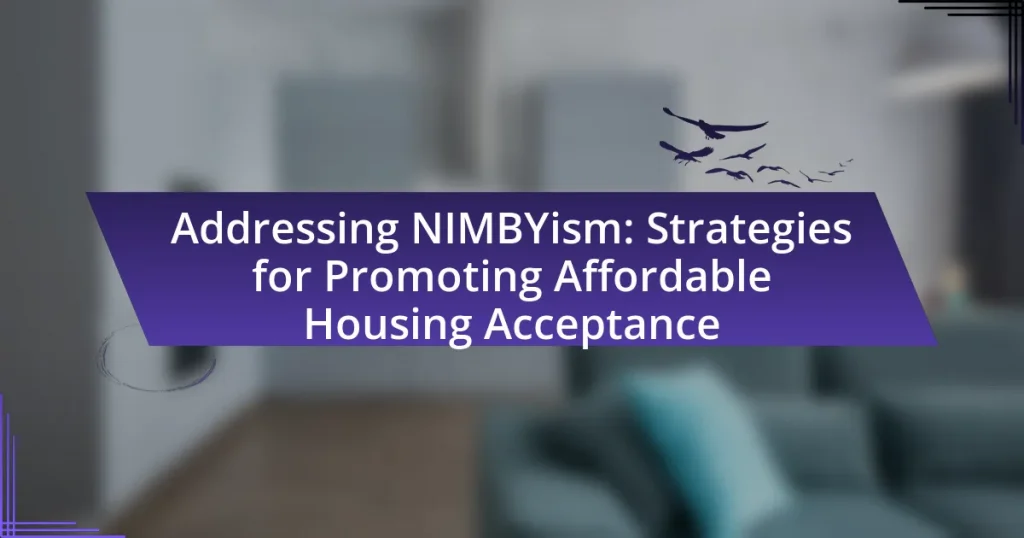The article examines the future of affordable housing in the context of the growing trend of remote work. It highlights how remote work is driving demand for housing in suburban and rural areas, as individuals prioritize affordability and quality of life over proximity to urban centers. Key factors influencing this shift include demographic changes, economic challenges, and the impact of zoning laws on housing development. The article also explores innovative solutions such as co-living spaces and modular homes, while discussing the role of community engagement and local government strategies in addressing the affordable housing crisis. Overall, it provides a comprehensive overview of the evolving landscape of affordable housing shaped by remote work dynamics.

What is the Future of Affordable Housing in the Age of Remote Work?
The future of affordable housing in the age of remote work is likely to see increased demand for housing in suburban and rural areas, as remote work allows individuals to live farther from their workplaces. This shift is supported by data indicating that 55% of remote workers prefer to live in less densely populated areas, seeking lower housing costs and improved quality of life. Additionally, developers may focus on creating mixed-use communities that integrate affordable housing with amenities, catering to the needs of remote workers who prioritize lifestyle over proximity to urban centers. This trend could lead to innovative housing solutions, such as co-living spaces and modular homes, which are cost-effective and adaptable to changing demands.
How is remote work influencing the demand for affordable housing?
Remote work is increasing the demand for affordable housing as individuals seek to relocate from high-cost urban areas to more affordable regions. This shift is driven by the flexibility remote work offers, allowing employees to prioritize cost of living over proximity to their workplace. According to a report by the National Association of Realtors, 49% of homebuyers in 2021 indicated that they were moving to less expensive areas, highlighting a significant trend towards affordable housing markets. As remote work becomes more permanent, the demand for affordable housing in suburban and rural areas is expected to rise, further influencing housing market dynamics.
What demographic shifts are occurring due to remote work?
Remote work is driving significant demographic shifts, particularly in residential patterns and workforce distribution. As employees gain the flexibility to work from anywhere, many are relocating from urban centers to suburban or rural areas, seeking more affordable housing options and improved quality of life. For instance, a study by the Pew Research Center found that 20% of remote workers moved to a different city or region during the pandemic, highlighting a trend towards decentralization. This migration is reshaping local economies, increasing demand for housing in previously less populated areas, and altering the demographic composition of communities as younger professionals and families seek out these new living environments.
How does remote work affect housing location preferences?
Remote work significantly alters housing location preferences by allowing individuals to prioritize factors such as affordability, lifestyle, and space over proximity to their workplace. As remote work becomes more prevalent, many employees are moving away from urban centers, where housing costs are typically higher, to suburban or rural areas that offer more affordable options and larger living spaces. A study by the Stanford Institute for Economic Policy Research found that remote work can lead to a 20% increase in the likelihood of moving to a less expensive area, demonstrating a clear shift in housing preferences driven by the flexibility of remote work arrangements.
What challenges does affordable housing face in this new landscape?
Affordable housing faces significant challenges in the current landscape, primarily due to rising demand and limited supply. The shift towards remote work has increased interest in suburban and rural areas, driving up housing prices in these regions. According to a report by the National Association of Realtors, home prices in suburban areas have surged by over 15% in the past year, exacerbating affordability issues. Additionally, the construction of new affordable units has slowed, with a 2022 study from the Urban Institute indicating that the number of affordable housing starts has decreased by 30% since 2010. This combination of heightened demand and reduced supply creates a critical barrier to accessing affordable housing for many individuals and families.
What economic factors are impacting affordable housing availability?
Economic factors impacting affordable housing availability include rising construction costs, stagnant wages, and increased demand for housing. Rising construction costs, driven by material shortages and supply chain disruptions, have made it more expensive to build new homes, limiting the supply of affordable options. Stagnant wages, particularly in low- and middle-income sectors, have not kept pace with housing prices, reducing purchasing power for many individuals and families. Additionally, increased demand for housing, fueled by urban migration and remote work trends, has intensified competition for available units, further driving up prices. According to the National Association of Home Builders, the cost of building a single-family home has increased by over 30% since 2020, highlighting the significant impact of these economic factors on affordable housing availability.
How do zoning laws and regulations affect affordable housing development?
Zoning laws and regulations significantly impact affordable housing development by dictating land use, density, and building types. These regulations can restrict the construction of multi-family units or impose minimum lot sizes, which limits the availability of affordable housing options. For instance, a study by the National Low Income Housing Coalition found that restrictive zoning contributes to a shortage of affordable housing, as it often prioritizes single-family homes over denser developments that could accommodate more residents. Additionally, zoning regulations can increase development costs through lengthy approval processes and compliance with specific design standards, further hindering the creation of affordable housing.
What innovative solutions are emerging for affordable housing?
Innovative solutions emerging for affordable housing include modular construction, which significantly reduces building costs and time. This method utilizes pre-fabricated sections that are assembled on-site, leading to faster completion and lower labor expenses. Additionally, 3D printing technology is being adopted to create homes at a fraction of traditional costs; for instance, ICON, a construction technology company, has successfully printed homes for around $10,000 each. Furthermore, community land trusts are gaining traction, allowing communities to collectively own land and ensure long-term affordability by removing it from the speculative market. These solutions are supported by various studies indicating their effectiveness in addressing housing shortages and affordability challenges.
How are technology and remote work shaping new housing models?
Technology and remote work are significantly shaping new housing models by increasing demand for flexible living spaces that accommodate home offices and communal areas. As more companies adopt remote work policies, individuals prioritize homes that offer dedicated workspaces, high-speed internet access, and proximity to amenities that support a work-life balance. For instance, a report by the National Association of Realtors indicates that 54% of remote workers prefer homes with designated office spaces, reflecting a shift in housing design to meet these needs. Additionally, technology facilitates the rise of co-living arrangements, where shared spaces promote community and reduce costs, aligning with the growing trend of remote work.
What role do co-living spaces play in affordable housing solutions?
Co-living spaces serve as a viable solution for affordable housing by providing shared living arrangements that reduce individual housing costs. These spaces typically offer lower rent compared to traditional apartments, as costs are distributed among multiple residents sharing common areas and amenities. According to a report by JLL, co-living can reduce living expenses by up to 30% in urban areas, making it an attractive option for young professionals and remote workers seeking affordable housing solutions. Additionally, co-living fosters community and collaboration, which can enhance the living experience and support networking opportunities among residents.
How can communities adapt to the changing needs for affordable housing?
Communities can adapt to the changing needs for affordable housing by implementing mixed-use developments that integrate residential, commercial, and recreational spaces. This approach not only maximizes land use but also creates vibrant neighborhoods that attract diverse populations. For instance, cities like Minneapolis have adopted policies to allow for greater density and mixed-use zoning, which has led to an increase in affordable housing options. Additionally, communities can leverage public-private partnerships to fund affordable housing projects, as seen in initiatives across various urban areas where collaboration has resulted in the construction of thousands of affordable units. These strategies demonstrate effective responses to the evolving demands for affordable housing in the context of remote work, where flexibility and accessibility are increasingly prioritized.
What strategies can local governments implement to support affordable housing?
Local governments can implement strategies such as inclusionary zoning, which requires developers to set aside a percentage of new housing units for affordable housing. This approach has been adopted in cities like San Francisco, where it has resulted in thousands of affordable units being created. Additionally, local governments can provide financial incentives, such as tax credits or grants, to developers who build affordable housing, as seen in programs like the Low-Income Housing Tax Credit, which has financed over 3 million affordable homes since its inception. Furthermore, local governments can streamline the permitting process to reduce costs and time for affordable housing projects, thereby encouraging more development. These strategies collectively enhance the availability of affordable housing in communities.
How can community engagement enhance affordable housing initiatives?
Community engagement can enhance affordable housing initiatives by fostering collaboration between stakeholders, ensuring that developments meet the actual needs of residents. Engaged communities can provide valuable insights into local housing demands, preferences, and potential barriers, which can lead to more effective and tailored housing solutions. For instance, a study by the Urban Institute found that community involvement in planning processes significantly increases the likelihood of successful housing projects, as it aligns developments with the specific desires and requirements of the community. This participatory approach not only builds trust but also encourages local investment and support, ultimately leading to more sustainable and accepted affordable housing solutions.
What are the long-term implications of remote work on affordable housing?
Remote work is likely to exacerbate the affordable housing crisis by increasing demand for housing in suburban and rural areas, where remote workers seek lower living costs and more space. As companies adopt flexible work policies, individuals may relocate from high-cost urban centers to more affordable regions, driving up housing prices in those areas. For instance, a study by Zillow in 2021 found that remote work has led to a 20% increase in home prices in suburban markets compared to urban areas. This trend can strain local housing markets, making it more difficult for low-income residents to find affordable options. Additionally, the shift may lead to a decrease in investment in urban affordable housing projects, as developers focus on higher-margin suburban developments.
How might urban planning evolve in response to remote work trends?
Urban planning may evolve to prioritize mixed-use developments and decentralized urban centers in response to remote work trends. As more individuals work from home, the demand for traditional office spaces decreases, prompting planners to redesign urban areas to include residential, commercial, and recreational spaces within close proximity. This shift can lead to the creation of “15-minute cities,” where residents can access essential services within a short walk or bike ride, reducing reliance on transportation. Additionally, urban planners may focus on enhancing digital infrastructure to support remote work, ensuring high-speed internet access in all neighborhoods. This evolution aligns with trends indicating that 30% of the workforce may continue to work remotely post-pandemic, necessitating a rethinking of urban layouts to accommodate changing lifestyles and housing needs.
What lessons can be learned from current affordable housing experiments?
Current affordable housing experiments reveal that innovative financing models, such as public-private partnerships, can effectively increase housing supply while maintaining affordability. For instance, cities like Minneapolis have implemented zoning reforms that allow for greater density, which has led to a measurable increase in affordable units. Additionally, these experiments highlight the importance of community engagement in the planning process, as seen in initiatives like the Community Land Trusts in Burlington, Vermont, which ensure long-term affordability and local input. Data from the National Low Income Housing Coalition indicates that areas with strong community involvement in housing decisions experience better outcomes in terms of resident satisfaction and housing stability.
What practical steps can individuals take to advocate for affordable housing?
Individuals can advocate for affordable housing by engaging in community organizing and participating in local government meetings. By attending city council sessions, individuals can voice their support for affordable housing initiatives and influence policy decisions. Additionally, forming or joining advocacy groups focused on housing can amplify their efforts, as collective action often leads to greater impact. Research shows that communities with active housing advocacy groups are more likely to see successful affordable housing policies implemented. Furthermore, individuals can educate themselves and others about the importance of affordable housing, using data from sources like the National Low Income Housing Coalition, which reports that there is a shortage of 7 million affordable rental homes for extremely low-income renters.



